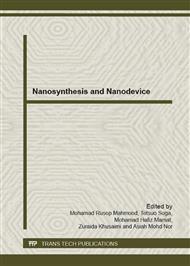[1]
S. Ijima, Helical microtubules of graphitic carbon, Nature 354 (1991) 56-58.
Google Scholar
[2]
W. B. Choi, D. S. Chung, J. H. Kang, H. Y. Kim, Y. W. Jin, I. T. Tan, Y. H. Lee, J. E. Jung, N. S. Lee, G. S. Park, J. M. Kim, Fully sealed, high-brightness carbon-nanotube field-emission display, Appl. Phys. Lett. 75 (1999) 3129-3131.
DOI: 10.1063/1.125253
Google Scholar
[3]
Q. H. Wang, M. Yan, R. P. H. Chang, Flat panel display prototype using gated carbon nanotube field emitters, Appl. Phys. Lett., 78 (2001) 1294-1296.
DOI: 10.1063/1.1351847
Google Scholar
[4]
J. I. Sohn, S. Lee, Y. H. Song, S. Y. Choi, K. I. Cho, K. S. Nam, Patterned selective growth of carbon nanotubes and large field emission from vertically well-aligned carbon nanotube field emitter arrays, Appl. Phys. Lett., 78 (2001) 901-903.
DOI: 10.1063/1.1335846
Google Scholar
[5]
Y. Saito, and S. Uemura, Field emission from carbon nanotubes and its application to electron sources, Carbon, 38 (2000) 169-182.
DOI: 10.1016/s0008-6223(99)00139-6
Google Scholar
[6]
J. M. Bonard, J. P. Salvetat, T Stockli, L. Forro, A. Chatelain, Field emission from carbon nanotubes: perspectives for applications and clues to the emission mechanism, Appl. Phys. A, 69 (1999) 245-254.
DOI: 10.1007/s003390050998
Google Scholar
[7]
A. Modi, N. Koratkar, E. Lass, B. Wei, and P. M. Ajayan, Miniaturized Gas Ionization Sensors using Carbon Nanotubes, Nature, 424 (2003) 171-174.
DOI: 10.1038/nature01777
Google Scholar
[8]
Z. Hou, H. Liu, X. Wei, J. Wu, W. Zhau, Y. Zhang, D. Xu, B. Cai, MEMS-based microelectrode system incorporating carbon nanotubes for ionization gas sensing, Sens. and Actuators B, 127 (2007) 637-648.
DOI: 10.1016/j.snb.2007.05.026
Google Scholar
[9]
Z. Hou, J. Wu, W. Zhou, X. Wei, D. Xu, Y. Zhang, and B. Cai, A MEMS-Based Ionization Gas Sensor Using Carbon Nanotubes, IEEE Trans. Elect. Dev., 54 (2007) 1545-1548.
DOI: 10.1109/ted.2007.896370
Google Scholar
[10]
H. Guohua, W. Lili, P. Min, C. Yuquan, L. Ting, Z. Xiaobin, Carbon nanotube gas sensor based on corona discharge, Chin J Anal Chem, 34, 12 (2006) 1813-1816.
Google Scholar
[11]
C. K. Birdsall, Particle-in-Cell Charged Particle Simulations Plus Monte Carlo Collisions With Neutral Atoms, PIC-MCC, IEEE Trans. on Plasma Sci., 19 (1991) 65-85.
DOI: 10.1109/27.106800
Google Scholar
[12]
Verboncoeur, J.P., M.V. Alves, V. Vahedi, and C.K. Birdsall, Simultaneous Potential and Circuit Solution for 1D Bounded Plasma Particle Simulation Codes, J. Comp. Physics, 104 (1993) 321-328.
DOI: 10.1006/jcph.1993.1034
Google Scholar
[13]
H. C. Kim, F. Iza, S. S. Yang, M. Radmilovic-Radjenovic, and J. K. Lee, Particle and fluid simulations of low-temperature plasma discharge: benchmarks and kinetic effects, J. Phys. D: Appl. Phys. 38 (2005) R283-R301.
DOI: 10.1088/0022-3727/38/19/r01
Google Scholar
[14]
J. M. Bonard, M. Croci, C. Klinke, R. Kurt, O. Nouri, N. Weiss, Carbon nanotube films as electron field emitters, Carbon, 40 (2002) 1715-1728.
DOI: 10.1016/s0008-6223(02)00011-8
Google Scholar
[15]
R. C. Smith, L. D. Filip, J. D. Carey, and S. R. P. Silva, Calculation of field enhancement factor and screening effects in carbon nanotube arrays, IEEE 20th IVNC, (2007) 171-172.
DOI: 10.1109/ivnc.2007.4480983
Google Scholar
[16]
J. Y. Huang, K. Kempa, S. H. Jo, S. Chen, and Z. F. Ren, Giant field enhancement at carbon nanotube tips induced by multistage effect, Appl. Phys. Lett. 87 (2005) 053110, 1-3.
DOI: 10.1063/1.2008363
Google Scholar
[17]
Y. Liu, S. Fan, Field emission properties of carbon nanotubes grown on silicon nanowire arrays, Solid State Comm., 133 (2005) 131-134.
DOI: 10.1016/j.ssc.2004.09.058
Google Scholar
[18]
A. M. Rao, D. Jacques, R. C. Haddon, W. Zhu, C. Bower, S. Jin, In situ-grown carbon nanotube array with excellent field emission characteristics, Appl. Phys. Lett., 76 (2000) 3813-3815.
DOI: 10.1063/1.126790
Google Scholar
[19]
Y. P. Raizer, Gas Discharge Physics, Springer, (1991).
Google Scholar
[20]
M. R. Radjenovic, Z. L. Petrovic, and B. Radjenovic, Modelling of breakdown behavior by PIC/MCC code with improved secondary emission models, IOP Publishing, Jour. Of Phys.: Conference series 71 (2007) 012007.
DOI: 10.1088/1742-6596/71/1/012007
Google Scholar
[21]
T. Ito, T. Izaki, and K. Terashima, Application of Microscale Plasma to Material Processing, Thin Solid Films 386 (2001) 300-304.
DOI: 10.1016/s0040-6090(00)01670-9
Google Scholar


